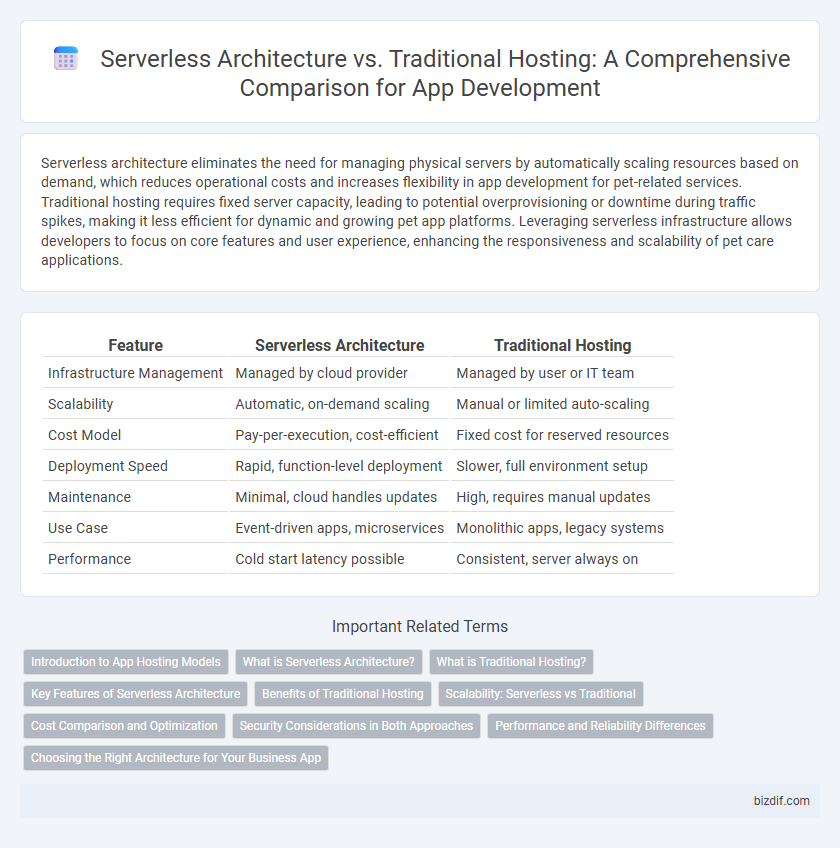Serverless architecture eliminates the need for managing physical servers by automatically scaling resources based on demand, which reduces operational costs and increases flexibility in app development for pet-related services. Traditional hosting requires fixed server capacity, leading to potential overprovisioning or downtime during traffic spikes, making it less efficient for dynamic and growing pet app platforms. Leveraging serverless infrastructure allows developers to focus on core features and user experience, enhancing the responsiveness and scalability of pet care applications.
Table of Comparison
| Feature | Serverless Architecture | Traditional Hosting |
|---|---|---|
| Infrastructure Management | Managed by cloud provider | Managed by user or IT team |
| Scalability | Automatic, on-demand scaling | Manual or limited auto-scaling |
| Cost Model | Pay-per-execution, cost-efficient | Fixed cost for reserved resources |
| Deployment Speed | Rapid, function-level deployment | Slower, full environment setup |
| Maintenance | Minimal, cloud handles updates | High, requires manual updates |
| Use Case | Event-driven apps, microservices | Monolithic apps, legacy systems |
| Performance | Cold start latency possible | Consistent, server always on |
Introduction to App Hosting Models
Serverless architecture eliminates the need for managing servers by automatically scaling resources based on demand, reducing operational overhead for app developers. Traditional hosting involves dedicated or shared servers where developers are responsible for maintaining the infrastructure, which can lead to higher costs and complexity. Choosing the right app hosting model depends on factors like scalability, control, and cost-efficiency tailored to the specific application requirements.
What is Serverless Architecture?
Serverless architecture is a cloud computing execution model where the cloud provider dynamically manages the allocation and provisioning of servers, allowing developers to build and run applications without managing infrastructure. This architecture enables automatic scaling, event-driven execution, and cost-efficiency by charging only for actual usage instead of pre-allocated server capacity. It contrasts with traditional hosting by eliminating the need for dedicated servers and simplifying deployment workflows.
What is Traditional Hosting?
Traditional hosting involves deploying applications on physical or virtual servers managed by a hosting provider, requiring manual setup, maintenance, and scaling. This model relies on fixed server resources, often leading to higher costs and limited flexibility during traffic spikes. It contrasts with serverless architecture by necessitating constant server management and capacity planning to ensure application performance.
Key Features of Serverless Architecture
Serverless architecture eliminates the need for server management by automatically provisioning and scaling resources based on demand, enabling seamless handling of variable workloads. It offers event-driven execution, where functions run in response to triggers, optimizing resource usage and costs by charging only for actual compute time. Enhanced scalability, reduced operational overhead, and integrated backend services such as databases and authentication make serverless a versatile choice for modern app development.
Benefits of Traditional Hosting
Traditional hosting offers consistent performance with dedicated resources, ensuring reliable uptime and faster load times for applications. It provides greater control over server configuration, security settings, and custom software installations, enabling tailored environments for complex app requirements. Predictable monthly pricing and established support services make traditional hosting a cost-effective choice for businesses with steady and high-traffic workloads.
Scalability: Serverless vs Traditional
Serverless architecture offers automatic scalability by dynamically allocating resources based on actual demand, eliminating the need for manual intervention. Traditional hosting requires pre-configured capacity planning and often involves over-provisioning to handle peak loads, resulting in inefficient resource usage. The inherent elasticity of serverless models enables developers to efficiently manage fluctuating traffic without downtime or performance degradation.
Cost Comparison and Optimization
Serverless architecture reduces costs by eliminating the need for provisioning and maintaining fixed server infrastructure, charging only for actual usage, which optimizes resource expenditure. Traditional hosting incurs consistent expenses due to reserved server capacity and ongoing maintenance, leading to potential overprovisioning and underutilized resources. Cost optimization in serverless setups benefits from auto-scaling and granular billing, whereas traditional hosting requires careful capacity planning to avoid redundant costs.
Security Considerations in Both Approaches
Serverless architecture enhances security by abstracting server management, reducing exposure to OS-level vulnerabilities and automating patching through cloud providers like AWS Lambda and Azure Functions. Traditional hosting demands meticulous manual security configurations, including firewalls, intrusion detection systems, and regular OS patching to prevent exploits. Both approaches require strict identity and access management, encryption, and monitoring, but serverless environments benefit from provider-managed underlying infrastructure, while traditional hosting allows more granular control over security policies.
Performance and Reliability Differences
Serverless architecture offers dynamic scaling and reduced latency by automatically allocating resources based on demand, resulting in optimized performance compared to traditional hosting, which relies on fixed server capacity. Reliability improves in serverless environments through built-in redundancy and fault tolerance managed by cloud providers, minimizing downtime risks common in traditional hosting setups. Traditional hosting may require manual scaling and maintenance, potentially causing performance bottlenecks and increased failure points during traffic spikes.
Choosing the Right Architecture for Your Business App
Serverless architecture offers automatic scaling, reduced operational costs, and faster deployment compared to traditional hosting, which requires dedicated server management and fixed capacity planning. Businesses with fluctuating workloads and rapid development cycles benefit from serverless environments, while applications needing consistent high performance or legacy system integration may perform better on traditional servers. Evaluating factors like scalability, cost-efficiency, security requirements, and development speed ensures the choice of the most suitable architecture for your business app.
Serverless Architecture vs Traditional Hosting Infographic

 bizdif.com
bizdif.com